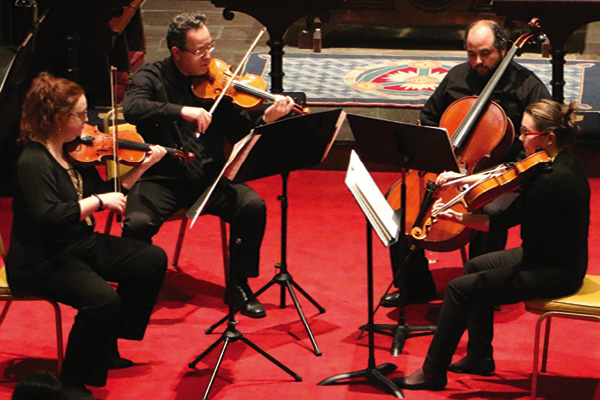October 9, 2021 Re-Invention!

Two Rivers String Quartet
PROGRAM NOTES
Tonight’s concert presents a fascinating look at the rise of the string quartet, a genre essentially invented by Haydn and perfected by him, together with Mozart. For this reason, Haydn is deservedly considered the “father of the string quartet.” Beethoven and Schubert soon after made important contributions of their own.
The two quartets we offer tonight showcase the beginnings of this great art form with Mozart’s first explorations of it and then the extraordinary heights that it reached almost three decades later with Haydn.
In 1770, Haydn had been devoting serious attention to the string quartet for nearly 20 years. Mozart, in contrast, was just composing his first quartet that year, when he was still just a teenager. In 1772 and 1773, Mozart went on to write his first set of six string quartets (sets of six being a publishing demand at the time). Tonight’s Mozart quartet is the second of those six works (but his third quartet chronologically, since, as noted above, he wrote his first in 1770). It is generally agreed to be among his finest early quartets. Fast forward to 1797 and 1798, after Mozart’s too-short life had ended and Haydn was still going strong. In these years, Haydn wrote his last set of six quartets, of which tonight’s No. 1 in G Major is a part. Together, this last set of quartets constitute Haydn’s Op. 76; in them, the quartet as a genre reaches its ideal form, the model from which all future composers would work.
Wolfgang Amadeus Mozart
(Born in Salzburg, Austria in 1756; died in Vienna in 1791)
String Quartet No. 3 in G major, K. 156
1. Presto
2. Adagio
3. Tempo di Menuetto
In the early days of string quartets, the prototypes were typically light in character, and Mozart began his first forays into that genre in that general spirit. While he was writing his first set of six quartets (K. 155–160) in 1772 and 1773, he was staying in Milan and also writing an Italian-style opera, Lucio Silla. Thus, these six quartets are nicknamed the Milanese Quartets, and they reflect a typically Italian style: light, breezy and comprising only three movements (in the manner of Italian opera overtures) instead of the four-movement structure that later became standard.
From the perspective of the history of the quartet, we should note that as Mozart was writing these early quartets Haydn had just published his exceptional “Sun” string quartets, Op. 20, the first masterpieces of the genre. It’s clear that Mozart at this point was yet to be influenced by Haydn’s trailblazing. Nevertheless, in only a year, when Mozart was back in Vienna, he had investigated Haydn’s quartets and begun his own trailblazing in earnest.
Nevertheless, Mozart’s early quartets show us solid musical craftsmanship, and they are intimate in nature and slightly exploratory. When we realize he wrote them when he was 16 and 17, they become rather extraordinary. And though the tenor of Quartet No. 3 in G major is indeed light, it has an undercurrent of solemn sentiment, and indeed, pathos, especially in the middle movement. It’s a wonderful look into the beginnings of this important genre, when this brilliant composer had essentially a blank canvas to work with, and seemingly composed simply at his pleasure.
Quartet No. 3 is foremost a work of incredible tenderness. Though fine musicianship is required to perform it, this quartet is not about bravura or virtuosity. The first movement is truly tender: a work of grace and gentle manners.
The second movement is thick with emotion. After the main theme sung by the violin, the rest of the quartet creates a gripping accompaniment with suspended chords, rich with harmonies and sonic depth. It’s clear that Mozart had a mind full of opera here: the songlike main theme, the dramatic feel of the piece, and a wonderful little duet near the movement’s center––as the violin theme yearns, the world calls back to that pining heart with little pitch turns called mordents, evoking the trills of night sounds and rustling breezes.
The third and final movement is in the form of a minuet, a dance of refinement and charm. But Mozart makes it something more involved, allowing the four instruments to begin what will later be called a “a four-part conversation,” which is one of the great hallmarks that makes this genre so desirable and important. Here, the melodies are lyrical and light but bear an unmistakable sobriety, a hint of sadness amidst its dancing. To balance this, the last section comes around bright and cheery, ending this early work of a master with a crystalline lightness.
In all, Mozart wrote 26 string quartets, dedicating six to Haydn. His last string quartets are regarded as masterworks of extraordinary depth and craft.
Joseph Haydn
(Born in Rohau, Austria in 1732; died in Vienna in 1809)
String Quartet No. 1 in G major, Op.76
1. Allegro con spirito
2. Adagio sostenuto
3. Menuet. Presto
4. Finale: Allegro ma non troppo
Haydn would complete a total of 68 string quartets since beginning his long relationship with them in the 1750s. Tonight, you’ll hear one of his crowning achievements in this genre that he essentially invented: Quartet No. 1 in G major, which begins his last and inarguably finest set of six, Op. 76, written in 1797 and 1798. Filled with craft, genius, playfulness and inventiveness, Op. 76 would influence Beethoven and Schubert immediately, and many later composers.
The opening to No. 1’s first movement clearly announces Haydn’s intentions for his entire set. The first three forte chords of the introduction serve an important purpose: to call the era’s notoriously noisy audiences to sit and hear and to be prepared for the imaginative bars to come. The first theme begins with the cello, a sure mark of the progression of the quartet as “a four-part conversation.” Haydn here seems to be beginning a fugue: the next instrument to enter is the viola, imitating the cello’s theme in typical fugue style, and so on … almost. But the fugue fails to materialize, and we hear, instead, duets on the theme, then a trio, until at long last we hear all four instruments together for the first time since the introduction. We then realize that Haydn, a master of this kind of playfulness, has called us to attention for what will be many pleasant surprises. Among them, listen for a marvelous moment at about one minute in when the entire quartet begins playing wild arpeggios in unison: another surprise and another high-water mark of this genre, in which ensemble virtuosity is becoming just as necessary as individual musicianship.
The middle movement is exceptionally lovely: melancholic, but with a soaring spirit, as though age has captured the body, but the mind is still able to frolic. It’s a hymn, in a sense, and explores the capabilities of the string quartet as an almost vocal ensemble.
The third movement’s unique treatment would make an indelible impact on the likes of Beethoven and his successors. Couched as the dance movement minuet (recall Mozart’s last movement, Tempo di Minuetto, heard earlier), Haydn makes the tempo un-danceable at breakneck speed and popping with anything-but-refined-and-charming sonic eruptions. For Beethoven, this phrasing would morph into his own wild scherzos. Haydn’s central section, however, is disarmingly dancelike and dainty––another example of Haydn’s mischievous sense of humor.
The typical finale of a string quartet, as Haydn himself had crafted the genre, is cast solidly in a major key, joyful and meant to resolve all the tensions from the previous movements. Not so here, and deliciously not. Almost the entire movement is in the minor key, and it explores some murky harmonic moments. Along the way, listen for virtuosic showcasing of the first violin and reprises of the virtuosic ensemble unison playing from the first movement. Last, and as if almost an afterthought, Haydn gives us the final bars in the major key that we had been expecting to wrap up everything, but with a theme of an unexpected kind of nonchalance. And for the sake of surprise, the final three bars are the very three forte chords that began the whole quartet. In every way, this is a masterpiece that confirms why the genre, thanks to Haydn and Mozart as its brilliant creators, became a lodestar of Western music.
–– Program notes © Max Derrickson


